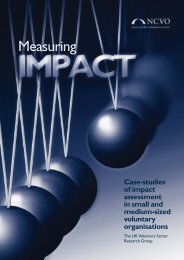A guide to third sector trading - WCVA
A guide to third sector trading - WCVA
A guide to third sector trading - WCVA
You also want an ePaper? Increase the reach of your titles
YUMPU automatically turns print PDFs into web optimized ePapers that Google loves.
It’s an idea, but is it business? A <strong>guide</strong> <strong>to</strong> <strong>third</strong> sec<strong>to</strong>r <strong>trading</strong><br />
1: Getting<br />
started<br />
2: First steps 3: Business<br />
planning<br />
4: Legal and<br />
governance<br />
5: Funding<br />
and<br />
resourcing<br />
6: Financial<br />
controls<br />
7: Managing<br />
growth<br />
8: Management<br />
and<br />
governance<br />
9: Social<br />
enterprise<br />
10: Sources<br />
of support<br />
• What does it do? The balance sheet is a snapshot of how<br />
much money you would have on any particular day (usually<br />
the last day of the month) if you could pile up the cash from<br />
all your bank accounts and cash boxes, if your cus<strong>to</strong>mers paid<br />
everything they owe you, if you sold all the <strong>trading</strong> s<strong>to</strong>ck you<br />
are holding, and if you then paid off all your debts <strong>to</strong> your<br />
suppliers, any outstanding VAT and Inland Revenue payments,<br />
and any bank loans. It is a precise snapshot of what the <strong>trading</strong><br />
part of the business is worth.<br />
• What does it say? The sum you end up with is your net current<br />
assets. It is not a real amount of money, so don’t get <strong>to</strong>o excited<br />
by it. But it can be a valuable indica<strong>to</strong>r of how your enterprise is<br />
performing month <strong>to</strong> month. If the figure is minus rather than<br />
plus there had better be a good reason – such as a loan for<br />
investment in the business. Otherwise you could be in serious<br />
trouble.<br />
• What does it not say? Just ignore items which you can’t easily<br />
or realistically turn in<strong>to</strong> cash – such as equipment and buildings.<br />
They will dis<strong>to</strong>rt the picture, and could be difficult <strong>to</strong> assess. It<br />
won’t correspond <strong>to</strong> the balance sheet in your annual accounts,<br />
and this is why it’s called ‘simplified’.<br />
The monthly income and expenditure account report:<br />
• What it is: The income and expenditure account at its simplest<br />
tells you what money has come in and what has gone out<br />
(itemised under standard headings, including separate sales<br />
figures if you have more than one <strong>trading</strong> activity) in the course<br />
of the past month.<br />
• What it says: This will help <strong>to</strong> show whether your bank balance<br />
has gone up and down, but not much more.<br />
• What it does: The two accounts provide an opportunity for<br />
scrutiny of the way the business is spending its money and<br />
discussions about how it is earning it. That’s entirely legitimate.<br />
Unfortunately, there is a terrible tendency for the expenditure<br />
account <strong>to</strong> provoke distracting debates which have little <strong>to</strong> do<br />
with business performance. Managers do well <strong>to</strong> head off these<br />
discussions as soon as possible if they are not relevant.<br />
• What it does not do: The income and expenditure account is<br />
an expected aspect of the finance report, and many reports<br />
will insist on it. But, depending on the type of activity, other<br />
information such as budget comparisons, can be more useful.<br />
155












